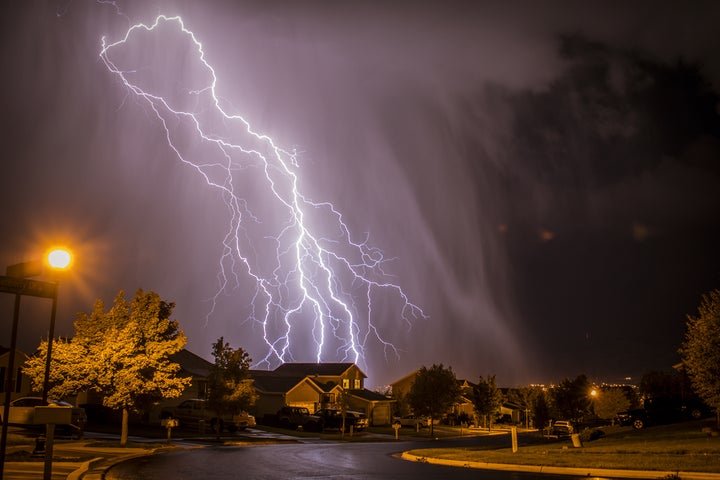
Tucked away just up the stairs and off the impressive lobby of one of Charleston, South Carolina’s historic mid-peninsula hotels, the Colonial Room seems as good a place as any to pick up the scent of southern intrigue, with the titans of the fire marshal community writing another chapter in the intriguing (but frustrating) story of how the yellow flexible pipe that brings fuel gas into millions of American homes may be vulnerable to lightning strikes – and responsible for who knows how many fires.
Some say the stuff is safe enough. Others contend it is one lightning strike away from becoming a blow-torch in your home.
Welcome to one of the nation’s least-known fire safety discussions, the kind of “regulation” that beguiles the public because, dramatic as life-and-death can be, it plays out not in two-hour TV dramas but over decades of meetings like those in the Colonial Room. Indeed, one of the landmark media spotlights hitting the flexible gas pipeline debate came in an ABC News “Good Morning America” report 10 years ago (October of 2007).
That truly alarming report by Elisabeth Leamy began by saying “an estimated 2 million homes have a kind of gas pipe that can explode in flames during a lightning storm, but very few people are aware of it.”
Fast forward ten years to Charleston, August 2017, and the annual meeting of the National Association of State Fire Marshals (NASFM). I’m there to follow the story and immediately learned that the homes-at-risk estimate has grown to approximately 10 million homes and the material in question, yellow corrugated stainless steel tubing or CSST, is still in routine use virtually nationwide.
But not everywhere. And that's a bit part of the story.
I picked up the CSST controversy years ago as Lubbock, Texas, became the first U.S. community to halt use of yellow CSST, but allowing another type of “black CSST” when local officials became convinced the new stuff offered significantly improved lightning protection. I thought then, and think now, it’s a great example of how civil lawsuits can drive government reforms.
Lubbock led the reform for higher safety standards for CSST and a half-dozen towns were following suit, but that movement was recently preempted by the Texas legislature.
What struck me about the vendors and exhibitors at the NASFM meeting who were involved with the CSST issue is that they debate very well.
Some were making the case that the usual “yellow” CSST (it’s called that because it’s actually yellow but also to distinguish it from the stronger CSST, which is black) was safe enough if installed properly. NASFM argues that this next-level "black" CSST, the one using a system similar to the one that protects aircraft from lightning, should be the new regulatory standard nationwide just like in Lubbock.
While the industry might be locked into a somewhat circular debate, U.S. fire marshals most certainly are not. Neither is the Lightning Protection Institute (LPI), which made a robust presentation at the conference supporting the inclusion of the higher electrical arcing test standard for CSST.
“They may know their products,” one of LPI’s reps explained to me. “But we know lightning.”
This is where most of us start scratching our head: Wait, the lightning experts say we should include the higher standard. The national group representing the U.S. states’ fire marshals endorses the higher standard.
What’s the problem here, cost?
That’s what I thought. However, it turns out the safer product is only about $20 more per average home.
If you start asking questions, you soon find out that the nation’s fire code system is not really a “national” system but instead a patchwork of regulations adopted from a variety of sources. Many of them could be influenced by boards populated by the very companies being regulated.
In 2012, Lubbock city building code officials pushed reform. The death of Brennen Teel in a Lubbock house fire was attributed to yellow CSST failure due to a lightning strike. This led local officials to do extensive research resulting in declaring a yellow CSST moratorium and eventually transitioning laws to the higher-standard flexible pipe.
NASFM weighed heavily in support of banning yellow CSST for the higher standard. Based on their review of available research, NASFM felt strongly the minimum standard for arc resistant CSST needed to be elevated. Having spent considerable time and resources to overcome the issues with legacy installations of yellow jacketed CSST, NASFM advocated that further steps needed to be taken to ensure better performance of CSST for new installations.
Strong words. One of the officials driving reform went so far as to say Lubbock had taken “courageous” action.
What’s so darn “courageous” about improving a fuel gas piping regulation?
In the closing days of the Lubbock action, the local city council suddenly heard from Kent Hance, a former U.S. Representative and ex-chancellor of Texas Tech. Clearly, the big guns had come to town and Hance, representing Omega Flex, a CSST manufacturer, advocated for the status quo.
In the NASFM briefing, one of the nation’s leading experts in protecting homes from lightning, called on other states to follow the lead of Texas as it launches a three-year research project as part of a larger effort to document fires caused by CSST failures in lightning storms.
However, there’s more to know about what Texas is up to. You may have noticed recently that Texas is making headlines with “preemptive” laws preventing cities and towns from regulating everything from “sanctuary cities” to gender-specific bathrooms. Lawmakers did not stop there. Preemption has extended to halting safety improvements for CSST.
By all accounts, the preemption was a classic hardball political move powered by the CSST industry. H.B. 3257 was amended in the final hours of the legislative session so it was slam-dunked through the "process." One natural argument was avoiding a “patchwork” of regulations across the state, but the result is that fire safety officials in places like Lubbock had their power taken away by Austin lawmakers.
Are Kent Hance and the CSST industry suddenly lightning and fire safety experts?
It should be said that Omega Flex had an impressive information booth at the NASFM conference and those folks advocated that all CSST is safe if installed properly. Given the Texas preemption, it appears the industry is willing to invest big money in lobbyists to preserve the status quo.
In the meantime, it's been 10 years since that ABC News report; Brennen Teel died in 2012.
Lubbock, after doing its own research, didn’t need three more years of study. NASFM didn’t need three more years of study. The Lightning Protection Institute didn’t need three more years of study. Apparently Texas lawmakers somehow do?
Nothing confusing about that – that's just money & politics.
But it remains horribly disappointing.
